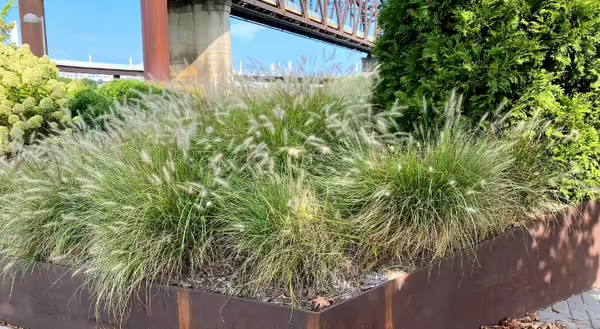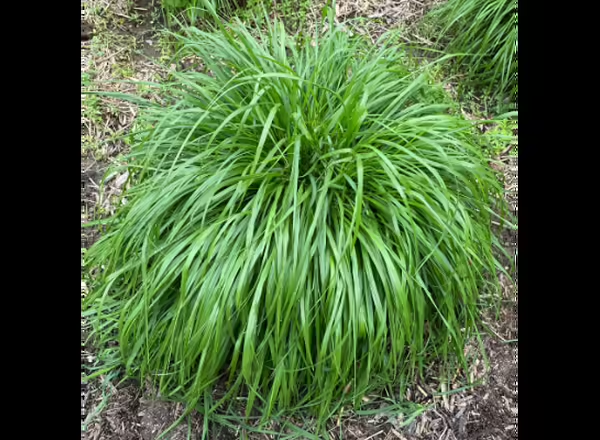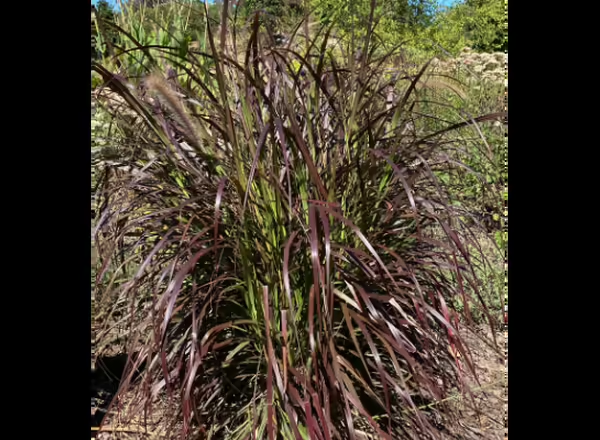
Several years ago on a hike in mid-November, I came across an unfamiliar grass. It was still green, with an intact seed head. The alarm bells started ringing in my head, like they do whenever I see green plants late into fall or very early in spring – was this grass native or non-native?
Many invasive species are adapted to stay green longer or green up earlier than native species, allowing them to get a head start on other plants in the area.
I took some pictures and discovered that it was Chinese Fountain Grass, Cenchrus alopecuroides, a non-native grass (formerly Pennisetum alopecuroides). You may have heard of this grass before, since it and many other species of Fountain Grasses, like Crimson Fountain Grass, Cenchrus setaceus, are popular ornamental grasses. Many different cultivars exist and are widely planted. Unfortunately, this means that the chances for escape from cultivation are that much higher. In the southwest part of the U.S., Crimson Fountain Grass is listed as an invasive species.
The following week my friend who works in Indiana reached out to me about a grass she found that she was unfamiliar with, and you guessed it, it was also Chinese Fountain Grass. Another inquiry came in from a homeowner who was seeing it in her pasture. One, two, three reports all in a short timeframe. My guess is this grass is underreported because of the difficulty that comes with identifying grasses, because some of them have a late bloom window, and because it is an escape from ornamental plantings.



What can you do?
Do not plant
The number one step you can take is not planting these grasses in your home landscape! Looking up planting and care instructions for these grasses led me to find notes that this grass can readily reseed and be aggressive. Finding this information about a non-native plant should be a warning that they have the potential to escape into natural areas and cause problems.
There are so many native grass options that you could plant instead. Check out a few from a previous blog post here.
Report it if you find it
The second step is to report it when you find it. Currently the distribution on EDDMapS shows that Chinese Fountain Grass only occurs in two counties in Illinois, but my guess is it’s more widespread and just underreported. Let’s review how to identify these grasses:
- Chinese Fountain Grass is a warm-season bunchgrass that can grow up to 3 feet tall, but the height varies depending on the cultivar. You can find hairs at the base of the leaf blades and along the stems. It flowers in late summer to early fall, producing a spike inflorescence. The spikelets are surrounded by long bristles that can range in color from whitish yellow to red to black depending on cultivar.
- Crimson Fountain Grass is a warm-season bunchgrass that can grow up to 4 feet tall. The leaves often have a reddish-purple hue to them. It flowers in late summer to early fall, producing a spike inflorescence. The spikelets are very hairy and surrounded by long bristles that range in color but are often red to purple.
Eradicate it if you find it on your property
The third step is to eradicate it if you find it. Depending on the size of the infestation and surrounding vegetation, you could dig out the plants, or you could use a grass-specific herbicide. If you have these grasses in your landscape, consider removing them before they can escape.
Learn more about these grasses:


Need a refresher on grass identification terms? Check out this blog post!
Thank you for reading!
Never miss a new post! Subscribe to our email list to get updates each time a new post is available.
Give us feedback! How helpful was this information (click one): Very helpful | Somewhat helpful | Not very helpful
ABOUT THE AUTHOR: Erin Garrett is a Natural Resources, Environment, and Energy Educator for University of Illinois Extension serving Alexander, Johnson, Massac, Pulaski, and Union counties. Erin develops and delivers high impact programming to adults and youth to help them develop an appreciation for natural resources and to empower them to make small changes to positively impact the environment. Erin’s programming focuses on why homeowners should consider choosing native plants, how to support native pollinators, how to identify grasses, how to identify and manage invasive species, and developing an appreciation for prairie ecosystems.